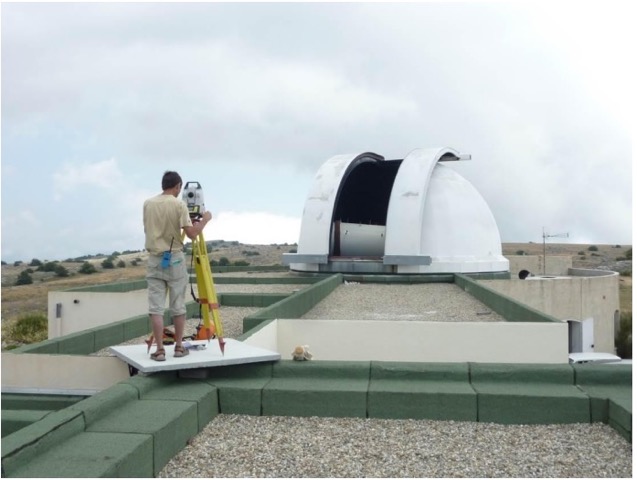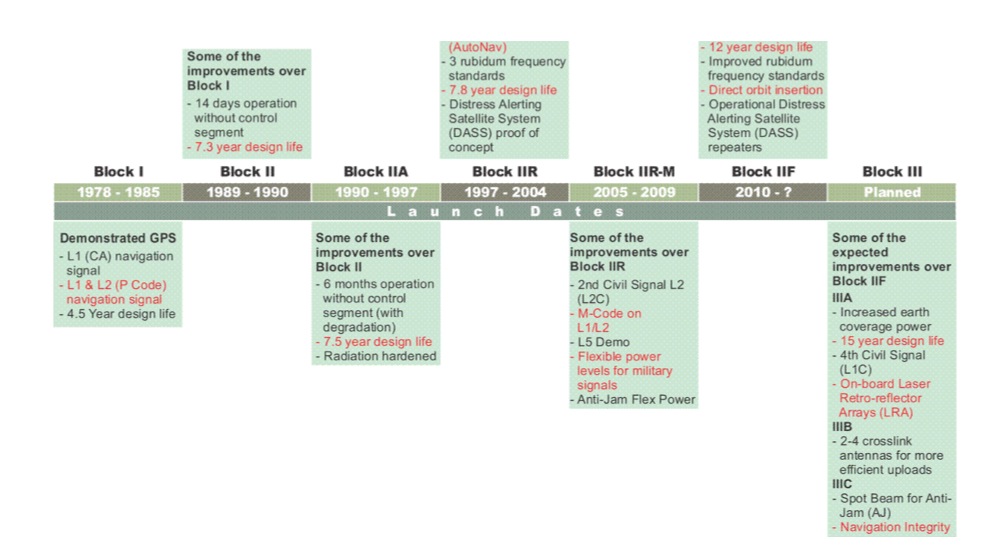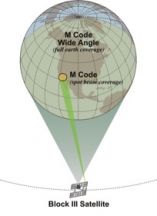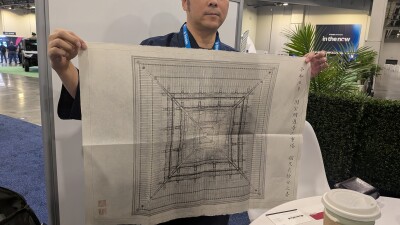GPS is critical to positioning, navigation, timing, the smooth functioning of financial transactions, air traffic, ATMs, and cell phones. Or: It is critical to modern life in general. As a result, it requires continuous modernization.
The oldest satellites in the current constellation were launched in the 1990s—imagine using a personal computer of that vintage today.
 1. The GPS satellites on orbit around the Earth have been replaced twice already. The first of the first-launched Block I satellites went up in 1978 and the last was retired in late 1995. The first of the Block II satellites was launched in 1989 and the last was decommissioned in 2007 after 17 years of operation.
1. The GPS satellites on orbit around the Earth have been replaced twice already. The first of the first-launched Block I satellites went up in 1978 and the last was retired in late 1995. The first of the Block II satellites was launched in 1989 and the last was decommissioned in 2007 after 17 years of operation.
2. The Block IIA satellites now in orbit are an improved version of the Block II. The first was launched in 1990, and the 6 of them still in commission are the oldest of the GPS satellites operating on orbit. They can operate without contacting the Control Segment for 6 months, but if that were to happen, their broadcast ephemeris and clock correction would degrade.
Two Block IIA satellites, SVN 35 and SVN 36, have been equipped with Laser Retro-reflector Arrays. The second of these was launched in 1994 and is still in service. Retro-reflectors facilitate satellite laser ranging, which measures the distance from the satellite to the earth.
3. In January of 1997, the first satellite launch of the next Block, Block IIR, was unsuccessful. The following launch in July of 1997 succeeded. There are 12 Block IIR satellites on orbit and operational. These satellites can determine their own position using inter-satellite crosslink ranging called AutoNav. In that mode, they can maintain full accuracy for 6 months. Some of the Block IIR satellites also have an improved antenna panel that provides more signal power. Despite their differences, Block IIA and the Block IIR broadcast the same fundamental GPS signals that have been in place for a long time. Their frequencies are centered on L1 and L2. The Coarse/Acquisition code or C/A-code is carried on L1. There are actually 32 different code sequences that can be used in the C/A code, more than enough for each satellite in the constellation to have its own. The Precise code or P(Y)-code on L1 and L2 is ten times more accurate than the C/A code, but unavailable to civilians.
Nine of the Block IIR satellites carry Distress Alerting Satellite System (DASS) repeaters. These DASS repeaters are used to relay distress signals from emergency beacons and were part of a proof of the concept of satellite-supported search and rescue that was completed in 2009. Twelve additional IIR satellites will carry them too.
4. There are 8 Block IIR-M satellites on orbit and operational. These upgraded satellites radiate two new codes; the M code (a military code) and the L2C code (a civilian code). They demonstrate a new carrier, L5. The L2C code helps in the correction of the ionospheric delay. One of the Block IIR-M satellites, SVN 49, transmits on L1, L2 and L5. L5 is a new carrier. The first of these Block IIR-M satellites was launched in the summer of 2005 and the last in the summer of 2009.

5. The latest block is Block IIF. The first Block IIF satellite was launched in the summer of 2010 as of 2014 there are 7 Block IIF satellites on orbit. GPS IIF-7 was launched August 1, 2014. They broadcast all of the previously mentioned signals, and L5 that will be available from all of the Block IIF satellites. The L5 signal is within the Aeronautical Radio Navigation Services frequency and can service aeronautical applications. All of the Block IIF satellites will carry DASS repeaters.
6. Block III satellites will replace the older Block IIR satellites as they are taken out of service. There are no Block III satellites on orbit yet. This block will be deployed in three increments. The first, Block IIIA, will be resistant to hostile jamming. The next two increments are Block IIIB and Block IIIC. Block IIIB will have higher power; IIIB and IIIC satellites will carry DASS repeaters and each Block III satellite will have three enhanced rubidium frequency standards.
There is a plan for these satellites that includes the broadcast of a new civilian signal, known as L1C, on the L1 carrier. This civilian signal was designed with international cooperation to maximize interoperability with Galileo’s Open Service Signal and Japan’s Quazi-Zenith Satellite System.
The broadcast of the Block III M code will change. It will continue to be radiated with a wide angle to cover the full earth just as in the Block IIR-M satellites, but the Block IIIC M code will also have a rather large deployable high-gain antenna to produce a directional spot beam. The spot beam will have approximately 100 times more power.






